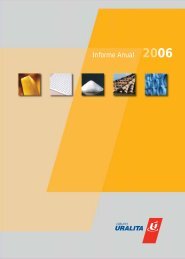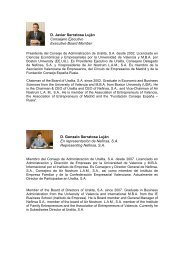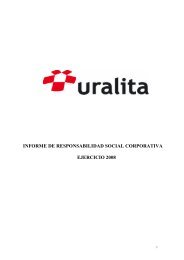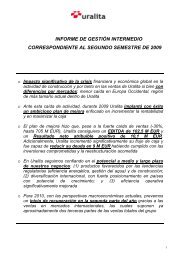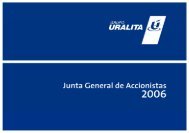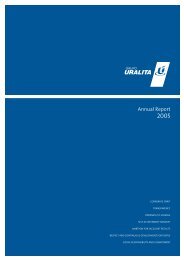Financial Information - Uralita
Financial Information - Uralita
Financial Information - Uralita
You also want an ePaper? Increase the reach of your titles
YUMPU automatically turns print PDFs into web optimized ePapers that Google loves.
FINANCIAL INFORMATION ANNUAL REPORT 2006<br />
Obsolete, defective or slow-moving inventories<br />
are valued at their lowest realisable value.<br />
4.9. <strong>Financial</strong> assets and liabilities<br />
Trade receivables<br />
<strong>Financial</strong> assets held by the Group basically<br />
relate to receivables generated by consolidated<br />
companies, which are recognized in the<br />
accompanying consolidated balance sheet under<br />
“Trade and other accounts receivable.” These<br />
assets are recognized at the nominal amount<br />
(considered to be equivalent to fair value) less<br />
any provisions for possible insolvency risks.<br />
Cash and cash equivalents<br />
• Bank loans<br />
Interest-bearing bank loans are recognized at<br />
the amount received less directly attributable<br />
transaction costs. <strong>Financial</strong> expenses, including<br />
premiums payable on settlement or repayment<br />
and direct issuing costs, are booked according<br />
to accrual criteria in the income statement using<br />
the effective interest method and are<br />
incorporated to the carrying amount of the<br />
instrument if not paid during the period in which<br />
they accrue.<br />
• Trade and other payables<br />
Trade payables are non-interest bearing and are<br />
recognized at nominal value.<br />
“Cash” includes both cash and sight deposits.<br />
“Cash equivalents" are short-term investments<br />
maturing in less than three months and which<br />
are not subject to a significant risk of change in<br />
value.<br />
<strong>Financial</strong> liabilities<br />
• Bonds and other long-term marketable<br />
securities<br />
These are measured at amortized cost using the<br />
effective interest rate method less any directly<br />
attributable issue costs. Amortized cost is the<br />
amount initially recognized minus principal<br />
repayments, plus or minus the cumulative<br />
amortization of any difference between the<br />
initially recognized amount and the maturity<br />
amount. Variations between the initial amount<br />
and the maturity amount that do not derive from<br />
the repayment of principal are recognized in the<br />
consolidated income statement for the year.<br />
Derivative financial instruments and hedge<br />
accounting<br />
The Group’s activities primarily expose it to<br />
financial risks from fluctuations in foreign<br />
exchange rates and interest rates. To hedge<br />
these risks, the Group uses currency swaps and<br />
interest-rate hedges. The Group does not use<br />
derivative instruments for speculative purposes.<br />
The use of derivatives is governed by the Group<br />
policies approved by the Board of Directors,<br />
which publishes in writing these principles on<br />
the use of derivatives.<br />
The effective portion of changes in the fair value<br />
of derivatives that are designated and qualify as<br />
cash flow hedges are recognized directly in<br />
equity. The gain or loss relating to the ineffective<br />
portion is recognized immediately in profit or<br />
loss. When the forecast transaction that is<br />
hedged results in the recognition of a non-<br />
145



